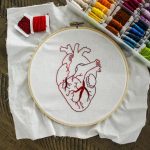When you stiffen fabric for sewing, you're not just enhancing its appearance; you're also improving its functionality in significant ways. You'll notice cleaner lines and sharper edges, which can elevate the overall quality of your projects. Moreover, stiffened fabrics resist wear and fraying, extending the life of your creations. This technique can also simplify your sewing process, reducing shifting and bunching. But what specific methods can you use to achieve the best results? Let's explore the various options available to you and how they can transform your sewing experience.
Table of Contents
Key Takeaways
- Stiffening fabric enhances structure, resulting in cleaner lines and sharper edges for a more polished appearance in sewing projects.
- It significantly boosts durability, preventing wear and tear, and helping fabrics resist fraying and sagging during use.
- Stiffened fabrics maintain their shape better throughout the sewing process, reducing the need for adjustments and ensuring a more straightforward sewing experience.
- The polished finish from stiffened fabric allows for neater seams and easier ironing, improving the overall quality of the finished project.
Enhanced Structure and Shape
Stiffening fabric gives your projects a more defined structure and shape, making them look polished and professional. Whether you're creating a bag, a costume, or home décor, using stiffeners can drastically enhance the overall appearance. You'll notice that your pieces hold their form better, allowing for cleaner lines and sharper edges.
When you work with lightweight or flimsy fabrics, they can often lack the support needed for detailed designs. By adding a stiffening agent, you provide the necessary backbone, ensuring that every fold and seam stands out. This is especially important in projects where precision is key, such as tailored garments or intricate accessories.
You'll also find that stiffened fabrics are easier to sew. They're less likely to shift or bunch up under your needle, allowing you to achieve more accurate stitching. Plus, they can help maintain the intended shape throughout the sewing process, reducing the need for excessive adjustments later on.
Improved Durability and Longevity
By adding a stiffening agent, you not only enhance your fabric's structure but also significantly boost its durability and longevity. This means your projects will withstand wear and tear much better than those made from untreated materials. Stiffened fabrics resist fraying and tearing, making them ideal for items that require frequent use, like bags, costumes, or home décor.
When you stiffen your fabric, you're providing an additional layer of protection against environmental factors like moisture, dust, and UV rays. This protection helps maintain the integrity of the material over time, ensuring it looks good for years to come. You'll find that stiffened fabric can withstand washing and cleaning better than softer alternatives, which often lose their shape and strength after repeated launderings.
Moreover, stiffening agents can help prevent sagging and stretching, preserving your fabric's original form. This is especially important for structured garments or upholstery, where maintaining the intended shape is crucial.
Polished Finish for Projects
A polished finish elevates your sewing projects, giving them a professional look that impresses and enhances their overall appeal. When you stiffen your fabric, you create clean lines and sharp edges that contribute to that polished aesthetic. This rigidity helps your fabric hold its shape, which is especially important for structured garments or home décor items like curtains and pillows.
You'll notice that seams become neater and more defined, eliminating the sloppiness that can occur with softer fabrics. Ironing becomes easier too; stiffened fabric responds well to pressing, ensuring that creases and folds remain crisp. Plus, it can make intricate details like pleats or ruffles stand out beautifully.
Stiffened fabric also allows for better finishing techniques, such as topstitching or binding edges. When you take the time to achieve a polished finish, you not only enhance the visual appeal of your project, but you also show pride in your craftsmanship.
Versatility in Fabric Types
You'll find that stiffening works well with a variety of fabric types, making it a versatile technique for any sewing project. Whether you're crafting home décor, clothing, or accessories, stiffening can enhance the performance and appearance of different materials.
Here's a quick overview of some popular fabric types that benefit from stiffening:
| Fabric Type | Benefits of Stiffening | Ideal Projects |
|---|---|---|
| Cotton | Increases structure and shape | Quilts, bags, and clothing |
| Tulle | Adds volume without weight | Tutus, veils, and decorations |
| Denim | Provides durability and support | Jeans, jackets, and bags |
| Silk | Prevents fraying and enhances drape | Blouses, scarves, and linings |
Tips for Effective Stiffening
Effective stiffening starts with choosing the right method for your specific fabric type and project. Each fabric reacts differently to stiffening agents, so it's essential to select one that complements your material. Here are some tips to ensure effective stiffening:
- Test First: Always do a small test on a scrap piece before applying stiffening to your entire project. This helps you gauge how the fabric will react.
- Choose the Right Stiffener: Depending on your needs, you might opt for fabric starch, interfacing, or even homemade solutions like sugar water. Each has its pros and cons.
- Apply Evenly: Whether you're spraying, brushing, or soaking, make sure to distribute the stiffening agent evenly across the fabric. Uneven application can lead to stiffness variations.
- Allow Proper Drying Time: After applying the stiffener, give your fabric enough time to dry completely. Rushing this step can compromise the stiffness and structure you're aiming for.
Frequently Asked Questions
What Types of Projects Benefit Most From Stiffened Fabric?
You'll find stiffened fabric works wonders for structured items like bags, home decor, and costume pieces. It adds shape and durability, making your projects look professional while enhancing their functionality and longevity.
Can I Stiffen Fabric Without Using Chemicals?
Yes, you can stiffen fabric without chemicals! Try using natural alternatives like cornstarch, sugar water, or even diluted white glue. Just mix, apply, and let it dry to achieve the desired stiffness for your projects.
How Does Stiffening Affect Fabric Drape?
Stiffening fabric changes its drape, making it hold its shape better. You'll notice a more structured appearance, which can enhance your design. However, it might lose some softness, so consider your project's needs carefully.
Is Stiffened Fabric Suitable for Children's Clothing?
Stiffened fabric can be suitable for children's clothing, but consider comfort and flexibility. If the stiffness restricts movement or irritates skin, it's better to choose softer materials that allow for play and activity.
How Do I Remove Stiffness From Fabric if Needed?
To remove stiffness from fabric, you can wash it with a gentle detergent, add fabric softener, or soak it in a vinegar solution. Rinse thoroughly, then air dry or tumble dry on low for best results.
- Tetron Fabric for Marine Applications: Durability and Use Cases - June 18, 2025
- Tetron Fabric for Outdoor Furniture: Weather Resistance and Care - June 18, 2025
- Tetron Fabric for Wall Coverings: Style and Application Tips - June 18, 2025






